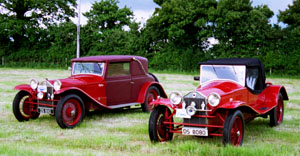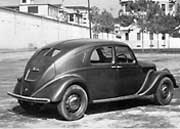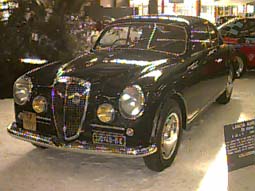Lancia began in 1906 when Vincenzo
Lancia, 25 years old at that time, and a colleague Claudio Fogolin, set
up their first factory to produce cars in Turin. He had gained a great
deal of experience working for Fiat, for whom he also drove cars in competitions.
The first Lancia was the Alpha which was
shown at the Turin motorshow in 1908. This set the trend for Lancia's in
being conventional but with innovative ideas such as a higher than normal revving
engine, a (patented) oil lubrcation system and an unusual carburettor.
This was followed by a series of new cars in the following years - the
Beta, Gamma, Delta, Epsilon, Eta, Zeta (gearbox and diff in one unit on
rear axle) and in 1913 the Thema (the first production car with a built
in electrical system).
After the second world war production of
the Aprilia and Ardea was continued, but Gianni, son of Vincenzo, who controlled
the company wanted a new model rather than developing these two cars. At
the Turin Motorshow in 1950 the Aurelia was
introduced, and as well as having an unusual layout of engine at the front
and gearbox, clutch and diff in a transaxle at the rear it also used the Again at the Turin Motorshow, this time
in 1957, a new Lancia was shown - the Flaminia.
The Flavia followed in 1960 and brought many
new ideas including front wheel drive (the first production car in Italy
with this layout) and split circuit hydraulic brakes with four discs. As
before, a small car to match, the Fulvia, was
introduced soon afterwards in 1963. The financial difficulties, however,
did not go away and in 1969 Fiat took control.
The Fulvia saloon and coupe were revised,
and the Flavia was replaced by the 2000, released
in 1971. A new car was urgently needed, and at Turin in 1972 the Beta
was presented. Designed by Fiat and using the Fiat twin-cam engine to drive
the front wheels the saloon was followed by a coupe, a spider, a two seat
mid engined sportscar, the Montecarlo, a 'lifestyle estate' the HPE and
a three box saloon, the Trevi. The seventies also saw the production of
the Stratos, designed and built (by Bertone) purely for rallying, at which
it was most successful, and the Gamma ,which started
as a joint venture with Citroen which collapsed part way through development
and was completed by Lancia alone.
The Delta was
introduced late in 1979 and awarded 'Car of the Year' the following year.
It was joined by the Prisma, effectively a Delta with a boot, in 1982,
and later development saw the Delta winning numerous rallies as first the
S4,
then the HF4WD and finally the integrale. In 1984 the Thema,
developed jointly with Alfa Romeo, Saab and Fiat returned Lancia to the
luxury market where it had been so successful in earlier years. In the
same year, but at the other end of the market, the Y10
was introduced, Lancia's first attempt at a 'city' car. In 1989 the Dedra,
developed from the Tipo alongside the Fiat
Tempra,
was introduced.
In 1994 the Kappa
was introduced to replace the Thema and in 1995 the Ypsilon
to replace the Y10. A new market segment was entered by Lancia in 1996
with the introduction of the Zeta, an MPV developed
jointly with Fiat, Peugeot and Citroen.
 During
the first world war Lancia produced trucks for the military but more cars
were to come. In 1919 the Kappa was released (and later Dikappa then Trikappa),
followed in 1922 by the Lambda. This was the first car to use a load bearing
body (no separate chassis) and independent front suspension (the sliding
pillar system which became so characteristic of Lancias). It proved a great
success and continued in production until 1931 in which time nearly 13,000
cars were produced. The Dilambda was a luxury car, and was followed by
the Artena and Astura, the latter pioneering the use of flexible engine
mountings. Also in the 1930's Lancia released the Augusta, the first 'small'
Lancia which combined the luxury and comfort expected of a Lancia wth a
smaller, more compact body, and later the Ardea.
During
the first world war Lancia produced trucks for the military but more cars
were to come. In 1919 the Kappa was released (and later Dikappa then Trikappa),
followed in 1922 by the Lambda. This was the first car to use a load bearing
body (no separate chassis) and independent front suspension (the sliding
pillar system which became so characteristic of Lancias). It proved a great
success and continued in production until 1931 in which time nearly 13,000
cars were produced. The Dilambda was a luxury car, and was followed by
the Artena and Astura, the latter pioneering the use of flexible engine
mountings. Also in the 1930's Lancia released the Augusta, the first 'small'
Lancia which combined the luxury and comfort expected of a Lancia wth a
smaller, more compact body, and later the Ardea.
 In
1937 the Aprilia entered production. This had
an aerodynamic bodyshell (of unitary construction and pillarless) which
was developed in the wind tunnel at Turin Polytechnic, had independent
suspension on all four wheels and was powered by a narrow angle V4. Tragically
Vincenzo Lancia never saw this car enter production as he died in February
1937 after suffering a heart attack. Production continued up until 1949.
In
1937 the Aprilia entered production. This had
an aerodynamic bodyshell (of unitary construction and pillarless) which
was developed in the wind tunnel at Turin Polytechnic, had independent
suspension on all four wheels and was powered by a narrow angle V4. Tragically
Vincenzo Lancia never saw this car enter production as he died in February
1937 after suffering a heart attack. Production continued up until 1949.
 first
production V6 in the world. It was soon joined by the B20 GT and later
the Spider, designed by Pininfarina. In 1953 the smaller stablemate of
the Aurelia, the Appia, was introduced. The Aurelia
was also the first Lancia to officially compete in motorsport, starting
in 1951, and gained many successes - especially at the expense of Alfa
Romeo. The next few years saw an ever increasing involvement in motorsport
until 1955 when the financial situation at Lancia was so bad that all motorsport
activities were stopped. The situation was so bad that Gianni was forced
to sell his majority holding in Lancia to Pesenti, a financial group.
first
production V6 in the world. It was soon joined by the B20 GT and later
the Spider, designed by Pininfarina. In 1953 the smaller stablemate of
the Aurelia, the Appia, was introduced. The Aurelia
was also the first Lancia to officially compete in motorsport, starting
in 1951, and gained many successes - especially at the expense of Alfa
Romeo. The next few years saw an ever increasing involvement in motorsport
until 1955 when the financial situation at Lancia was so bad that all motorsport
activities were stopped. The situation was so bad that Gianni was forced
to sell his majority holding in Lancia to Pesenti, a financial group.
The 1990's also saw the introduction of
the 'New Delta', a new car to replace the Delta
but continuing the name. And in 1999 the Lybra
was released, a replacement for the Dedra.
For books on the history of Lancia try our online bookshop - in Association with Amazon.com & Amazon.co.uk
Copyright © 2000 to 2008 CarsfromItaly